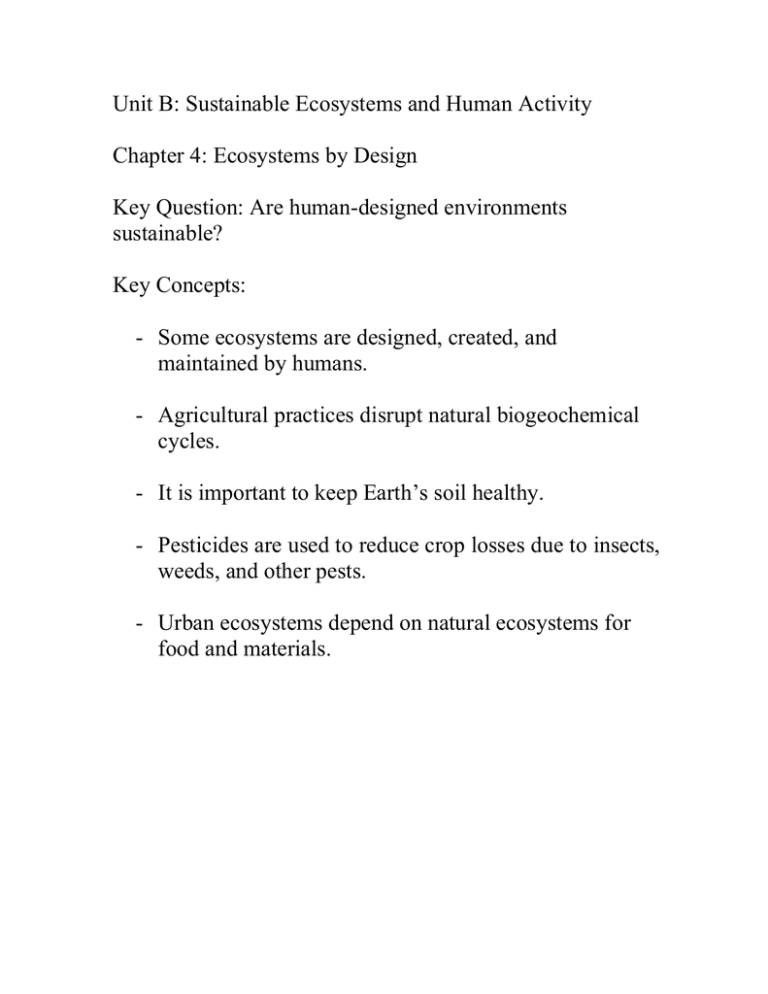Unit B: Sustainable Ecosystems and Human Activity
advertisement

Unit B: Sustainable Ecosystems and Human Activity Chapter 4: Ecosystems by Design Key Question: Are human-designed environments sustainable? Key Concepts: - Some ecosystems are designed, created, and maintained by humans. - Agricultural practices disrupt natural biogeochemical cycles. - It is important to keep Earth’s soil healthy. - Pesticides are used to reduce crop losses due to insects, weeds, and other pests. - Urban ecosystems depend on natural ecosystems for food and materials. 4.1: Engineering Ecosystems and Modern Agriculture pg. 126 Key Concepts: 1. Some ecosystems are designed, created, and maintained by humans. 2. Agricultural practices disrupt natural biogeochemical cycles. Comparing Natural and Engineered Ecosystems Humans spend little time in natural ecosystems, where all other organisms do. Humans can manipulate their surroundings to suit their needs. Areas designed and constructed by humans are known as engineered ecosystems, and are artificial. (Lawns, gardens, sports fields and farms) Engineered ecosystems are different from natural ecosystems. In a natural ecosystem, a human’s influence is equal to all the other organisms found there. These ecosystems have a greater diversity (variety) of organisms living there. The ecosystem is kept in balance through natural processes and relationships among the diverse organisms. In artificial ecosystems, there is very little diversity, because features have been added and removed on purpose. Humans must maintain these ecosystems or they would fail on their own. Modern Agriculture The agricultural industry in Canada is a major contributor to our survival. The food in which we eat come from all over Canada, P.E.I. produces the potatoes we eat, while British Columbia’s cranberries, and wheat from the Prairie provinces. Foods produced in Canada come from other parts of the world, which gives us the varieties of nutritious foods. Non-native animals and plants are now grown and raised here. Table1: Agricultural Products of Canada. Farmlands as Engineered Ecosystems Agro-ecosystem: is an agricultural ecosystem designed and maintained by humans to meet the human need for food. Engineered ecosystems are designed by humans to fulfill a specific role or function. The most common engineered ecosystem is the farm, which are designed to provide us with food and other products. Comparing Natural Ecosystems and Agro-ecosystems Pest: any plant, animal, or other living organism that causes illness or harm and is an annoyance to humans. In natural ecosystems, the organisms interact, and maintain the natural balance. Bees pollinate the flowers, rabbits eat grass and their waste is used as soil fertilizer. In an Agroecosystem, there are a limited number of species interacting, and the natural cycles no longer work. Plants are started in a greenhouse, only one type of crop is grown in a field. Bees and rabbits are no longer needed in the ecosystem. Figure 4: a) A natural ecosystem maintains its own balance of biotic and abiotic b) In an agro-ecosystem, humans work to maintain the balance. Monocultures Monocultures: agro-ecosystems (farms) consisting of single crops in an area. On farms, monoculture is the normal, only one type of crop is grown in a given area. Growing only one type of crop, allows the farmer to get the highest crop yield, there is no competition from other species. Crops can be harvested quickly and easily. In a monoculture, a single disease can kill the entire crop, causing the whole crop to collapse in a short time. These crops also put a strain on the soil, nutrients are depleted, and therefore, a large amount of fertilizer is required to support the crop. Check Your Learning: Questions 1 – 7, pg. 129 Wrap Up: - Humans change their surroundings to suit their needs. - Engineered ecosystems have low biodiversity. - Many engineered ecosystems are unsustainable because they lack the natural cycle necessary to keep the ecosystem in balance. - The most common type of engineered ecosystem is an agro-ecosystem. - Modern farming often involves planting fields of only one type of crop, known as monocultures. - Most of the crop and livestock species in Canada are nonnative species.







